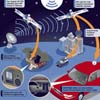| . |  |
. |
Geneva (AFP) Feb 07, 2006 The lives of around 1.5 million youngsters in the drought-stricken Horn of Africa are at risk, the United Nations Children's Fund (UNICEF) warned Thursday. UNICEF said the crisis, which has left eight million people in need of emergency aid in Ethiopia, Kenya, Somalia and Djibouti, was hitting children under the age of five particularly hard. "There is a potential for widespread disease, greater malnutrition and the displacement of significant numbers of people," said UNICEF head Ann Veneman in a statement. "The international community must respond immediately to the need for assistance," she added. With no rains failing in the region for the past two years, severe food and water shortages and mass livestock deaths have raised the spectre of famine. Hunger is driving up malnutrition rates among young children. In addition, measles also poses a growing threat because immunization rates are low in the affected areas, UNICEF said. Malnourished youngsters are at a much higher risk of infection, and the disease can spread lethally and fast in such a situation. UNICEF said it was boosting feeding programmes, and planned to step up vaccination and vitamin A campaigns as well as water and sanitation services. It said it also aimed to tackle the risk of abuse and exploitation of children which can be increased by loss of family income, movement of people in search of food and competition for limited resources. It also noted that many children have been pulled out of school to help their families search for food and water. The agency said it needed 16 million dollars to fund its aid effort.
Source: Agence France-Presse
Related Links  Andover MA (SPX) Feb 10, 2006
Andover MA (SPX) Feb 10, 2006WSI Corporation has announced that it is developing a system that will enable aircraft to receive WSI's leading aviation weather information over Sirius Satellite Radio, and Sirius' audio programming for passengers. The new WSI InFlight system will be available over Sirius for aircraft flying in the Sirius satellite coverage area. |
|
| The content herein, unless otherwise known to be public domain, are Copyright 1995-2006 - SpaceDaily.AFP and UPI Wire Stories are copyright Agence France-Presse and United Press International. ESA PortalReports are copyright European Space Agency. All NASA sourced material is public domain. Additionalcopyrights may apply in whole or part to other bona fide parties. Advertising does not imply endorsement,agreement or approval of any opinions, statements or information provided by SpaceDaily on any Web page published or hosted by SpaceDaily. Privacy Statement |